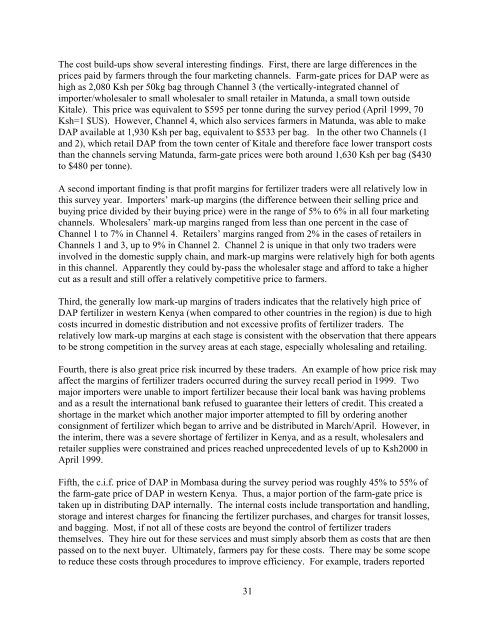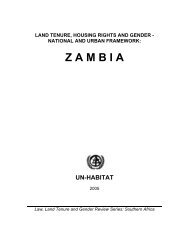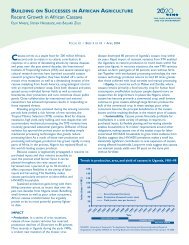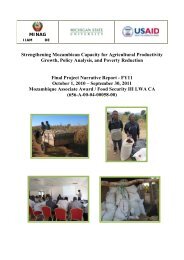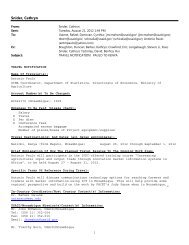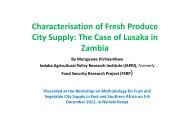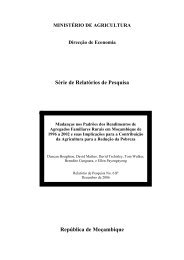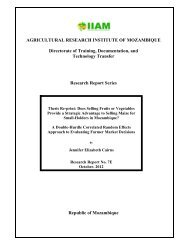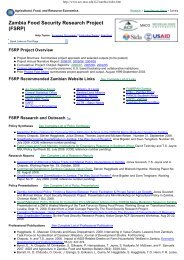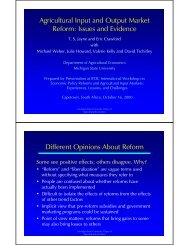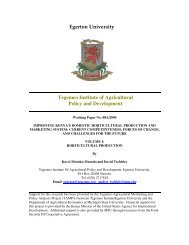Fertilizer Markets and Agricultural Production Incentives - Tegemeo ...
Fertilizer Markets and Agricultural Production Incentives - Tegemeo ...
Fertilizer Markets and Agricultural Production Incentives - Tegemeo ...
You also want an ePaper? Increase the reach of your titles
YUMPU automatically turns print PDFs into web optimized ePapers that Google loves.
The cost build-ups show several interesting findings. First, there are large differences in the<br />
prices paid by farmers through the four marketing channels. Farm-gate prices for DAP were as<br />
high as 2,080 Ksh per 50kg bag through Channel 3 (the vertically-integrated channel of<br />
importer/wholesaler to small wholesaler to small retailer in Matunda, a small town outside<br />
Kitale). This price was equivalent to $595 per tonne during the survey period (April 1999, 70<br />
Ksh=1 $US). However, Channel 4, which also services farmers in Matunda, was able to make<br />
DAP available at 1,930 Ksh per bag, equivalent to $533 per bag. In the other two Channels (1<br />
<strong>and</strong> 2), which retail DAP from the town center of Kitale <strong>and</strong> therefore face lower transport costs<br />
than the channels serving Matunda, farm-gate prices were both around 1,630 Ksh per bag ($430<br />
to $480 per tonne).<br />
A second important finding is that profit margins for fertilizer traders were all relatively low in<br />
this survey year. Importers’ mark-up margins (the difference between their selling price <strong>and</strong><br />
buying price divided by their buying price) were in the range of 5% to 6% in all four marketing<br />
channels. Wholesalers’ mark-up margins ranged from less than one percent in the case of<br />
Channel 1 to 7% in Channel 4. Retailers’ margins ranged from 2% in the cases of retailers in<br />
Channels 1 <strong>and</strong> 3, up to 9% in Channel 2. Channel 2 is unique in that only two traders were<br />
involved in the domestic supply chain, <strong>and</strong> mark-up margins were relatively high for both agents<br />
in this channel. Apparently they could by-pass the wholesaler stage <strong>and</strong> afford to take a higher<br />
cut as a result <strong>and</strong> still offer a relatively competitive price to farmers.<br />
Third, the generally low mark-up margins of traders indicates that the relatively high price of<br />
DAP fertilizer in western Kenya (when compared to other countries in the region) is due to high<br />
costs incurred in domestic distribution <strong>and</strong> not excessive profits of fertilizer traders. The<br />
relatively low mark-up margins at each stage is consistent with the observation that there appears<br />
to be strong competition in the survey areas at each stage, especially wholesaling <strong>and</strong> retailing.<br />
Fourth, there is also great price risk incurred by these traders. An example of how price risk may<br />
affect the margins of fertilizer traders occurred during the survey recall period in 1999. Two<br />
major importers were unable to import fertilizer because their local bank was having problems<br />
<strong>and</strong> as a result the international bank refused to guarantee their letters of credit. This created a<br />
shortage in the market which another major importer attempted to fill by ordering another<br />
consignment of fertilizer which began to arrive <strong>and</strong> be distributed in March/April. However, in<br />
the interim, there was a severe shortage of fertilizer in Kenya, <strong>and</strong> as a result, wholesalers <strong>and</strong><br />
retailer supplies were constrained <strong>and</strong> prices reached unprecedented levels of up to Ksh2000 in<br />
April 1999.<br />
Fifth, the c.i.f. price of DAP in Mombasa during the survey period was roughly 45% to 55% of<br />
the farm-gate price of DAP in western Kenya. Thus, a major portion of the farm-gate price is<br />
taken up in distributing DAP internally. The internal costs include transportation <strong>and</strong> h<strong>and</strong>ling,<br />
storage <strong>and</strong> interest charges for financing the fertilizer purchases, <strong>and</strong> charges for transit losses,<br />
<strong>and</strong> bagging. Most, if not all of these costs are beyond the control of fertilizer traders<br />
themselves. They hire out for these services <strong>and</strong> must simply absorb them as costs that are then<br />
passed on to the next buyer. Ultimately, farmers pay for these costs. There may be some scope<br />
to reduce these costs through procedures to improve efficiency. For example, traders reported<br />
31


